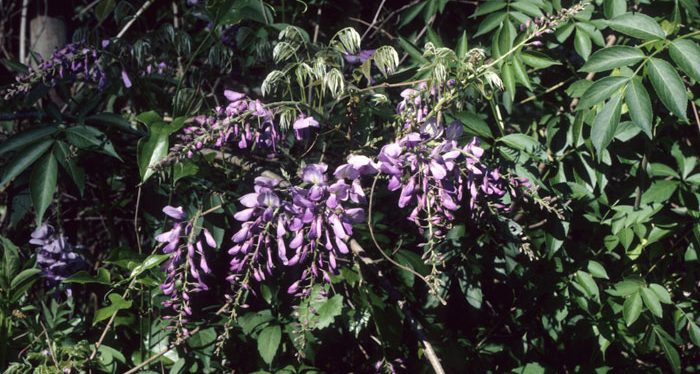
by Mary Salinas | Apr 6, 2015
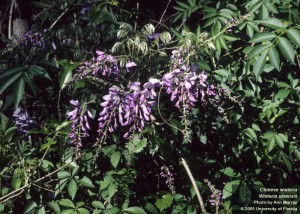 Maybe you have been seeing the Chinese wisteria, Wisteria chinensis, sporting its lavender blooms along the roadways this time of year. This vine may add a pleasant splash of color to the green leafy backdrop, but this is an invasive vine that has escaped our yards and gardens and is spreading on its own in natural communities.
Maybe you have been seeing the Chinese wisteria, Wisteria chinensis, sporting its lavender blooms along the roadways this time of year. This vine may add a pleasant splash of color to the green leafy backdrop, but this is an invasive vine that has escaped our yards and gardens and is spreading on its own in natural communities.
The University of Florida Assessment of Invasive Plants determined that this vine has caused long-term alterations in ecosystem processes and displaces native vegetation. According to the non-profit Florida Exotic Pest Plant Council (FLEPPC), Chinese wisteria is a category II invasive which means that the species has escaped cultivation and is spreading on its own into other unintended areas.
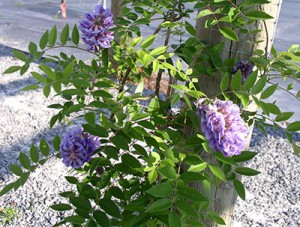
American Wisteria ‘Amethyst Falls’ at GCREC Teaching Gardens. Photo credit: UF/IFAS Extension.
Fortunately, there are several great alternatives to Chinese wisteria. A native vine, American wisteria, Wisteria frutescens, is a great alternative. The native cultivar ‘Amethyst Falls’ displays lovely fragrant lavender blooms in the spring and summer.
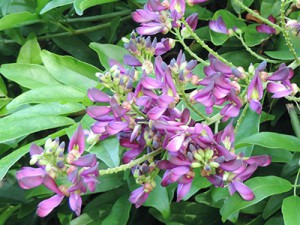
Evergreen Wisteria at the GCREC Teaching Garden. Photo credit: UF/IFAS Extension.
Another alternative is evergreen wisteria, Millettia reticulata, a twining vine (the stems twist around upright supports) that is semi-evergreen in the Florida panhandle. The deep mauve blooms appear throughout the summer months and persist often into the autumn.
So how do you get rid of the invasive Chinese wisteria? The vine can be severed at ground level and the stump immediately treated with a 25% solution of triclopyr or glysophate. There may be some resprouting of the vine from unaffected roots that would require retreating. Please click here for more details. The best time to control this vine is in the spring or summer when it is actively growing so that it will transport the herbicide to the roots and kill the plant.
For further information:
UF/IFAS Center for Aquatic and Invasive Plants: Chinese Wisteria
UF/IFAS Assessment of Invasive Plants: Chinese Wisteria
FLEPPC: 2013 List of Invasive Plants
UF/IFAS Gardening Solutions: American Wisteria ‘Amethyst Falls’
UF/IFAS Gardening Solutions: Evergreen Wisteria
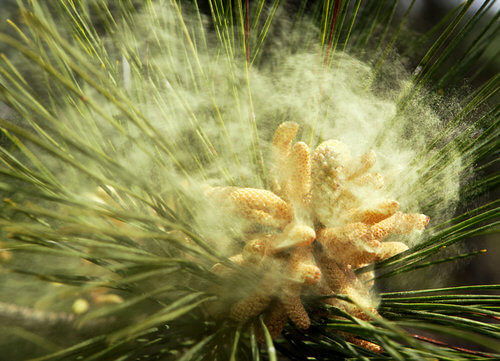
by Taylor Vandiver | Mar 24, 2015
It’s that time of year again, that time when your car changes color like a chameleon in order to mimic the surrounding landscape. Anything that stands still long enough will become coated with a light green to yellow dust. What is this dust you might ask? What you are seeing is pollen, a sure sign that spring has arrived and allergy season is here! The pollen that can be seen is from pine trees and is not a major contributor to allergies, but the invisible pollen from oak trees and other plants can wreak havoc on sinuses. And while you may be cursing the trees for causing your eyes to water and coating your car, it’s important to remember that plants need pollen in order to reproduce.

Pollen disseminating from a pine tree anther. Picture courtesy of http://supermanherbs.com/megadose-pine-pollen/
Pollen is disseminated from blooming trees and plants. The process of pollination develops new plant seeds. Pollen is dry and light, enabling it to float through the wind and travel several miles. Plants that depend on wind for dispersal have to produce massive amounts of pollen since only a small amount will actually result in seed production. Plants pollinated by insects don’t have to produce as much pollen because of the efficiency of the insects in distributing the pollen. Changes in the weather directly influence the amount of pollen and how it will affect allergy sufferers. Rain dampens pollen and reduces its ability to flow through the air. A freeze can also slow down a tree’s rate of producing pollen. Windy and warm weather can increase pollen amounts.
A Leon County allergy and asthma specialist stated that roughly 40 percent of the population suffers from pollen allergies. The best thing you can do if you are part of this 40 percent is to reduce your exposure to pollen. Here are a few ways you can keep your allergies at bay:
- Dry clothes in an automatic dryer rather than hanging them outside to avoid pollen collecting on clothing and being carried indoors.
- Consider limiting outdoor activities during the pollen season (Florida trees often release pollen from January to June).
- Stay inside during peak pollen times (from 10 a.m. to 4 p.m.).
- Restrict outdoor activities during days with high winds and low humidity.
- Shower after spending time outdoors to remove pollen from hair and skin.
- Use air filters and clean regularly, or run an air conditioner and change the air filter frequently.
- Wear a dust mask when mowing the lawn, gardening, or raking leaves.
If you would like to know what trees are producing pollen in your area at certain times of the year you can visit this website http://www.pollenlibrary.com/State/Florida/. As always, feel free to contact your local Extension Office for more information.

by Carrie Stevenson | Mar 17, 2015

A waterfront buffer zone may include a raised berm with native vegetation to slow runoff from a yard before entering the water. Photo credit: Carrie Stevenson
A taste of spring weather has arrived, and people will soon be filling the home improvement stores and getting ready for outdoor projects. If you live on the water or near a storm drain, it’s worth considering buffer zones and best management practices for fertilizing and lawn maintenance.
A waterfront buffer zone is an area the length of one’s property line, typically running about 10 feet (although it can be wider) from the edge of a shoreline (or even a storm drain) into the yard. In this area, the homeowner allows native vegetation to grow along the water and uses low-maintenance plants within the buffer. In this zone, no fertilizers or pesticides are used. Some homeowners will build a small berm to divide the area of maintained lawn (uphill) from the downhill waterfront side. This berm may be composed of a mulched area with shrubbery to catch and filter runoff from the more highly maintained lawn. This combination of actions helps treat potentially polluted stormwater runoff before it reaches the water, and keeps homeowners from using chemicals close to the water. It is often quite difficult to grow turf next to the water, anyway, and this takes the pressure off of someone trying to grow the perfect lawn down to the water’s edge. The buffer zones are often quite attractive and can be an excellent transition between managed turf and the waterfront.
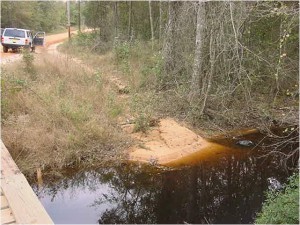
Unmaintained dirt roads along creeks are significant sources of sediment, which can harm the bottom-dwelling insects that form the base of the food web. Photo credit: Carrie Stevenson
Erosion prevention is crucial along waterways, as well. An open, non-vegetated lot can contribute a significant amount of sediment to a storm drain, stormwater pond, or natural body of water. Whether grass, trees, or bushes, any kind of vegetation is preferable to soil washing out of a yard and into the water. Sediment is a problem because it causes water clarity to drop, which can prevent seagrasses from getting the sunlight they need. Once settled, underwater sediment can form a stifling layer that chokes out small insects and invertebrates, which live in the soil and form the basis of the aquatic food chain. With no fish food available, fish may die or move out of an area. The most dramatic examples of this can often be found at dirt roads that cross over creeks. If not managed properly, the clay on these roads can nearly bury a small stream.
Other lawn care techniques for protecting the waterfront and preventing stormwater pollution include not mowing along the water, using a deflector shield and staying 3’-10’ away from the water’s edge when fertilizing, and not allowing grass clippings to blow into storm drains. Large amounts of decaying grass in a waterway can use up available oxygen, endangering aquatic organisms. When applying granular fertilizer, be sure to sweep up any spills on concrete so it doesn’t run into a storm drain. When cutting grass, mow at the highest height recommended for your turf to encourage deep rooting and stress tolerance. Healthy turf is better able to withstand drought, pests, and choke out weeds, reducing the frequency of pesticide and water application.
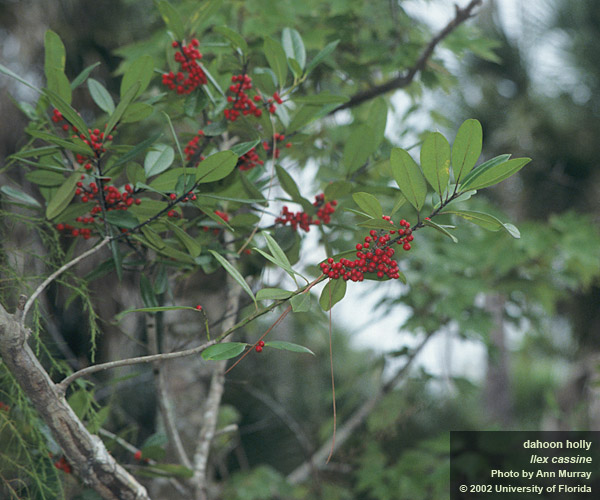
by Mary Salinas | Mar 2, 2015
The sight and sound of birds in the yard reconnects us to the wonder and beauty of nature. Providing food, water and shelter can bring the joy of our feathered friends into outdoor spaces.
 Leave behind the standard palette of trees and shrubs that characterize many urban landscapes. Rather, choose trees and shrubs that provide food and shelter to birds. Here are just a few to consider:
Leave behind the standard palette of trees and shrubs that characterize many urban landscapes. Rather, choose trees and shrubs that provide food and shelter to birds. Here are just a few to consider:
Hawthorns – The thorniness of these trees provide excellent protection for birds nesting in their strong branches. In spring, their abundance of blooms attracts a wide variety of pollinators. The size of the fruits vary with different species of hawthorn. For instance, the yellow haw (Crataegus flava) has large fruit suitable for larger birds, while the littlehip hawthorn (C. spathulata) produces small fruit for even the smallest of the fruit-eating birds.
Hollies – When most other fruiting trees are bare of fruit in winter, hollies provide abundant berries in the fall and hold them well into winter to provide food for migratory and resident songbirds. Dahoon holly is a versatile tree for many landscape settings, from dry, sunny locations to moist woodlands. It is even moderately salt tolerant.
Viburnums – This family of large shrubs are adaptable to a wide range of landscape situations. The dense foliage and branching provide excellent nesting opportunities for birds. Flowers bloom in spring to summer and are followed by purple fruits in late summer and fall that are enjoyed by many birds.

Songbird at a tube feeder. Photo by Thomas Wright, UF/IFAS.
Do you want to attract birds right away? While you wait for new plantings to mature and provide food, put out a few bird feeders. There are a wide variety from which to choose. Tube, hopper and platform feeders can be filled with a variety of seed mixes. Suet feeders are constructed of a heavy gauge wire and hold a solid cake of animal fat with seeds, nuts, grains or fruits. Nectar feeders cater to hummingbirds. Fruit feeders are made to hold large pieces of fruit, like apples and oranges. The type of feeder and food you offer will determine the species or type of birds you will attract.
Don’t forget a bird bath. Birds need a clean water source, so remember to rinse it on a regular basis.
Think twice about attracting birds, though, if you let your cats run free. Cats are dangerous to our bird populations. But if they are strictly housecats, they will love to watch the birds through the windows or porch screens as much or even more than you will.
For more information:
U.S. Fish & Wildlife Service: Backyard Bird Feeding
Attracting Backyard Birds: Bird Feeder Selection

by Les Harrison | Feb 24, 2015

Smilax is noted for its multiple thorns which scratch anyone who comes into contact
The yo-yo thermometer readings make it confusing for the panhandle’s human residents when choosing proper wardrobe selections. With few exceptions, the deciduous plants and trees continue to wait for consistently warmer weather and longer days before covering their trunks and stems with foliage.
The current season’s uncloaking allows for easy examination of the structure and configuration of what will be green and hidden in a few months. This exposure also reveals potentially painful hazards in the native landscape.
Smilax, the sinewy vine, puts up an intimidating barrier to man and beast. Also known as green briar, cat briar and other sometimes graphic terms, the native plant thrives in this area.
In Greek mythology, Smilax was a wood nymph who was transformed into a bramble after the unfulfilled and tragic love of a mortal man. Her final form in this fable was a reflection of her character.
Botanically, smilax is found in tropic to temperate zones. There are about 350 species worldwide and 12 in Florida, with nine being common.
The plant is very vigorous and is equipped with an enviable array of survival traits. It is ready to take every advantage to flourish and inhabit new territory, even under the most unfavorable conditions.
Individual plants can withstand harsh treatment and environments. If burned or mowed to the soil’s surface, they will regenerate from a segmented rhizome root system. Rhizome roots are the subterranean stems which spread roots and runners from its bulbous root nodes.
If pulled up, the rhizome root system will separate at joints. Even the smallest piece of root left in the dirt will generate a new plant.
Smilax has the additional resource of extra-floral nectaries, nectar-producing glands physically separate from the flowers. These nectaries may function as an organ for the plant to rid itself of metabolic wastes and/or to attract beneficial insects for pollination and defense.
Ants are especially attracted to the extra-floral nectaries in smilax and frequently establish mounds close by. The ants defend the smilax from herbivores which eat the leaves, if they can get past the thorns.
In addition to spreading by its root system, smilax produces berries which contain a seed. The berries appear in late summer or early autumn and ripen to a blue-black color.
The berries are usually consumed in winter after the smilax loses it leaves. Birds and animals will deposit the seed at a new site. Best chances for the seed to germinate occur after it is exposed to a freeze, as the panhandle has recently experienced.
Smilax vines will climb up trees, fence post, and any other stationary object to get better sun exposure. They have been known to reach over 30 feet in height, but do not tend to kill their host by shading out the sun.
Ants commonly use the vines as a readily available pathway on foraging trips. Ants may establish colonies in above ground locations, courtesy of smilax vines which provide a wide-reaching pathway.
Smilax can be controlled with some broadleaf herbicides, but repeated applications will be necessary. The best time to apply herbicides is in the early spring when the first leaves appear.
Once the leaves return, smilax can be difficult to identify and control, hidden in all the common greenery.
To learn more about smilax in Panhandle Florida read the Key to Nine Common Smilax Species of Florida or contact your local UF/IFAS Extension Office.
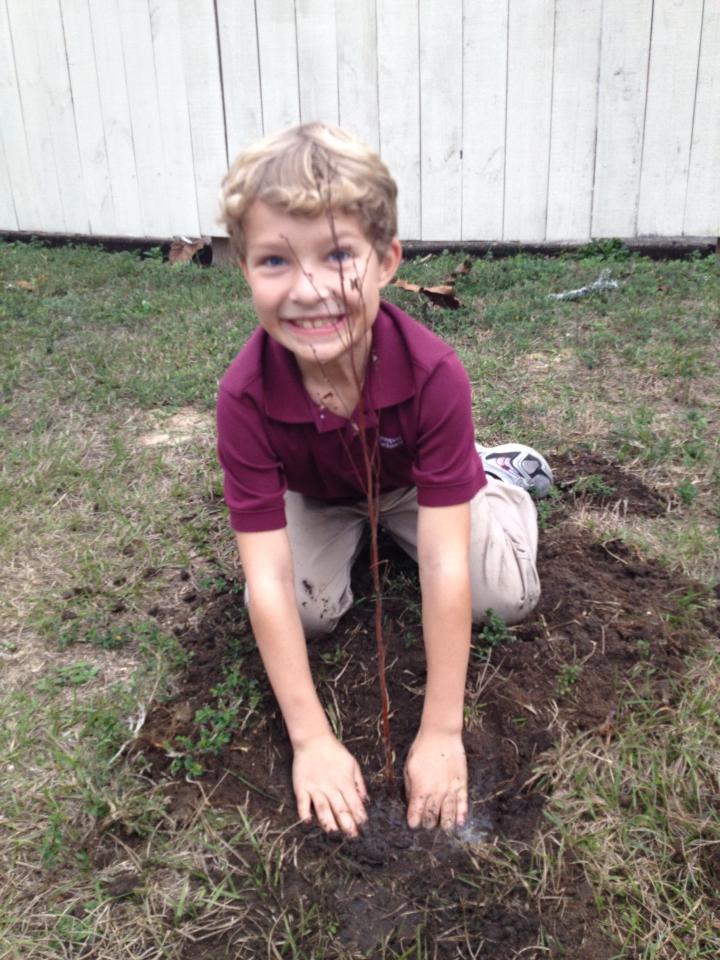
by Carrie Stevenson | Jan 13, 2015

Planting a tree is an excellent way to insure clean air and water in the future. Photo credit: Carrie Stevenson
Most of us begin a new year with resolutions–to exercise more, to eat right, to spend our time more productively–but few things have as many lasting impacts for the future as the simple act of planting a tree.
Arbor Day (which literally means, “Tree Day”) was founded in 1872 by J. Sterling Morton, a naturalist and journalist in Nebraska. By 1882, it was celebrated by thousands of schoolchildren nationwide, who planted trees and took care of them with their classmates. Today, millions of communities and schools celebrate Arbor Day all over the world. Trees provide endless benefits, including shade, recreation, food and building products, shade and wind protection, wildlife habitat, oxygen production and carbon dioxide uptake.
Arbor Day is typically celebrated in the United States on the last Friday of April, but as ideal tree-planting conditions differ by climate, each state has its own specific Arbor Day, as well. Winter is the ideal time to plant trees in Florida, because it allows roots to develop without expending energy on growing new leaves and shoots. Our state celebration this year is January 16th.
Many local communities in Florida hold special events around this time. Be sure to check with your local Extension office or Native Plant Society chapter to find out if they are offering free trees or public events this month. For more information on the best trees for your area, be sure to take the time to read “Native Trees for North Florida” or peruse the UF Environmental Horticulture web page.

 Maybe you have been seeing the Chinese wisteria, Wisteria chinensis, sporting its lavender blooms along the roadways this time of year. This vine may add a pleasant splash of color to the green leafy backdrop, but this is an invasive vine that has escaped our yards and gardens and is spreading on its own in natural communities.
Maybe you have been seeing the Chinese wisteria, Wisteria chinensis, sporting its lavender blooms along the roadways this time of year. This vine may add a pleasant splash of color to the green leafy backdrop, but this is an invasive vine that has escaped our yards and gardens and is spreading on its own in natural communities.











